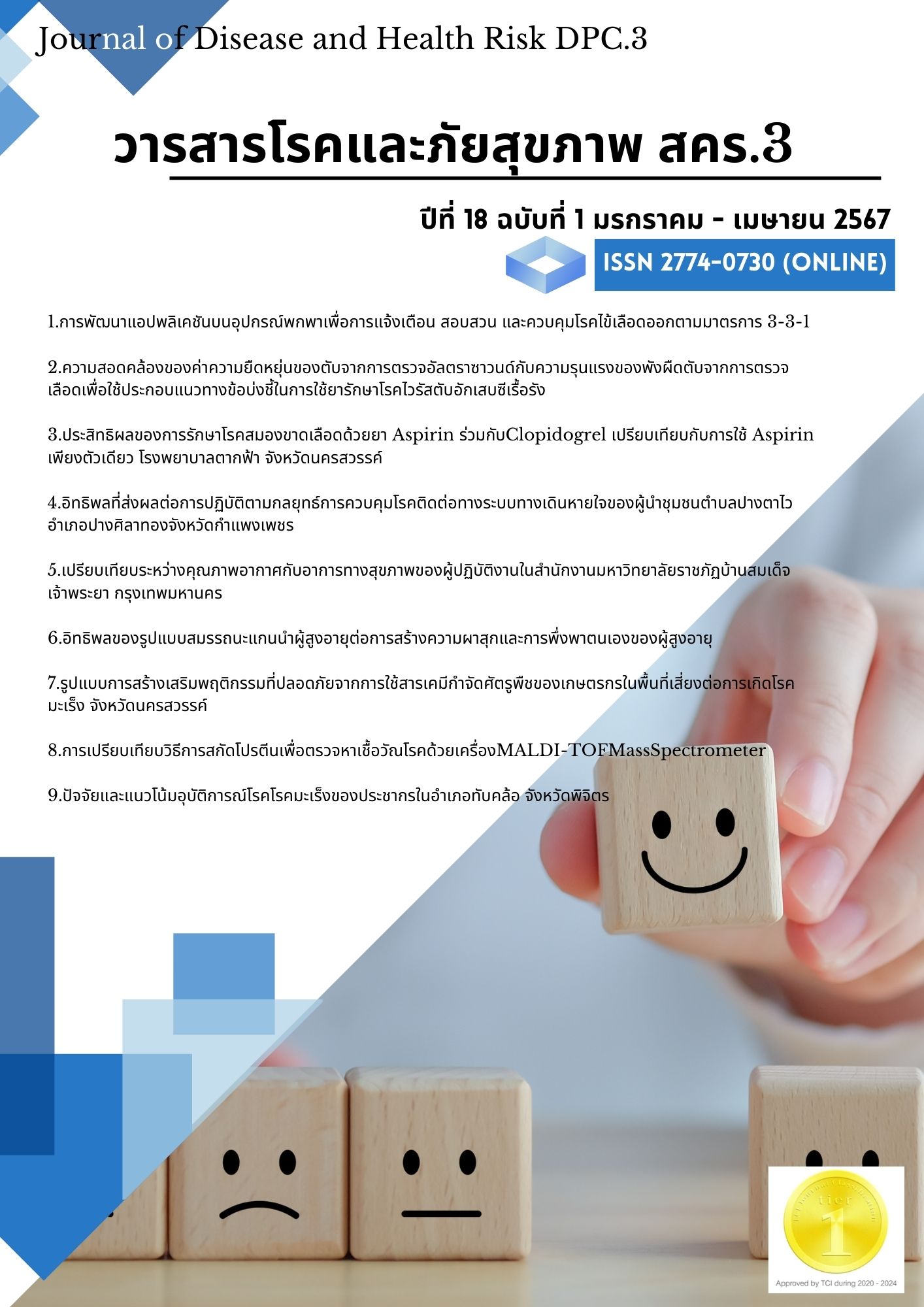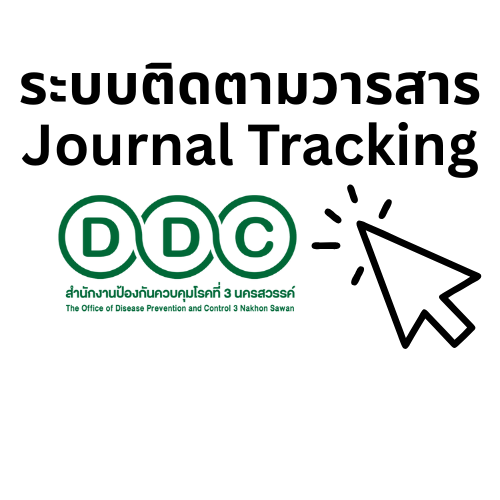The Model for Promoting Safety Behaviors of Pesticide Use among Farmers in an Area at Risk of Cancer in Nakhon Sawan Province
Keywords:
Pesticide, Safety behaviors, CancerAbstract
The objective of this quasi-experimental research is to study the model for promoting safety behavior from pesticide use among farmers in areas at risk of cancer and to study the effectiveness of the pattern. The study was conducted in an experimental group of 50 people and a control group of 50 people. From the study of the pattern of promoting safety behavior from pesticide use among farmers according to the ADDIE process (Analysis-Design-Development-Implement-Evaluation), the experimental group organized a brainstorming session to analyze the behavior and situation of using pesticides, set goals, and strategies and created the application Nakhon Sawan, safe from toxicity, far from cancer as a source of information and exchange of health literacy to promote knowledge and safe behavior from the use of chemical pesticides among farmers. The results of the effectiveness study of the model by comparison results of knowledge and safe behavior from the use of pesticides between the experimental group and the control group with independent t-test or Mann Whitey U test, it was found that before the experiment knowledge, and safe behavior from the use of pesticides among farmers in all aspects of the two groups were not different. After participating in promoting safe behavior from the use of pesticides among farmers program in areas at risk of cancer, the experimental group had an average of knowledge and safe behavior from the use of chemical pesticides higher than the control groups with statistical significance (p-value < 0.05). Therefore, the model for promoting safe behavior from the use of pesticides by farmers in areas at risk for cancer should be promoted to other groups of farmers to increase the level of knowledge and safe behavior of pesticide use among farmers. To conduct self-protective behavior from the use of pesticides and reduce health and cancer risks from exposure to pesticides.
References
Mustapha FA, Dawood GA, Mohammed SA, Vimala YD, and Binson MT. Pesticide Knowledge and Practices among Farm Workers in Kuwait: Results of a Survey. International Journal of Environmental Research and Public Health, 2017;18, 8803.
Gross K., Rosenheim JA. Quantifying secondary pest outbreaks in cotton and their monetary cost with causal inference statistics. 2011; Ecol. Appl., 21, 2770-80.
Arias-Estevez M, Lopez-Periago E, Martinez-Carballo E , Simal-Gandara J, Mejuto JC, Garcia-Rio L. The mobility and degradation of pesticides in soils and the pollution of groundwater resources. Agric. Ecosyst. Environ. 2008;123, 247-60.
Alavanja MC, Bonner MR. Occupational pesticide exposures and cancer risk:
A review. J Toxicol Environ Health, 2012; 15(4), 238-63.
Parron T, Requena M, Hernandez AF, Alarcon R. Environmental exposure to pesticides and cancer risk in multiple human organ systems. Toxicology Lett, 2014; 230, 157-165.
Mostafalou, S., and Abdollahi, M. Pesticides and human chronic diseases: Evidences, mechanisms, and perspectives. Toxicology and Applied Pharmacology, 2013; 268, 157-177.
International Agency for Research on Cancer. Globocan Cancer Fact Sheet. USA: The World Health Organization. 2020.
International Agency for Research on Cancer. Thailand cancer statistics 2019: Globocan. USA: The World Health Organization. 2020
National Cancer Institute of Thailand and Thai Cancer Base. Report of Cancer in Thailand. Department of Medical, Ministry of Public Health, Thailand. 2020
Kangkhetkron T, Juntarawijit C. Pesticide exposure and lung cancer risk: A case-control study in Nakhon Sawan, Thailand. F1000Research. 2023. https://doi.org/10.12688/f1000research.24114.7
Kangkhetkron, T., and Juntarawijit, C. Factors Influencing Practice of Pesticide Use and Acute Health Symptoms among Farmers in Nakhon Sawan, Thailand. International Journal of Environmental Research and Public Health, 2021; 18, 8803.
Tawatsin A, Thavara U, Siriyasatien P. Pesticides Used in Thailand and Toxic Effect to Human Health. Medical Research Arch,2015; 3, 1-10.
Patel SR, Margolies PJ, Covell NH, Lipscomb C, Dixon LB. Using Instructional Design, Analyze, Design, Develop, Implement, and Evaluate, to Develop-Learning Modules to Disseminate Supported Employment for Community Behavioral Health Treatment Programs in New York State. Frontiers in Public Health, 2018; 6(113), 1-9.
Glass GW, McGaw B, Smith ML. Meta-analysis in social research. Newbury Park: Sage Publications. 1981.
Grove B, Gray. Evaluating the English and Thai Versions of the Psychological Well-Being Scale across Four Samples. Psychology, 2020; 11(1).
Juntarawijit C. et al. Chronic diseases among Thai farmers and associated risk factors Report. Faculty of Agricultural Natural and Environment, Naresuan University, Pitsanulok. 2019
Nutbeam D. Defining, measuring, and improving health literacy. Health Evaluation and Promotion, 2015; 42(4), 450-55.
Bloom BS. Taxonomy of Educational Objectives: Handbook 1 Cognitive Domain, Longman: London, UK. 1956.
Mostafavi F, Ghofranipour F, Feizi A, Pirzadeh A. Improving physical activity and metabolic syndrome indicators in women: a trans theoretical model-based intervention. International Journal Preventive Medication, 2015; 1(6), 28.
Aeksanti T, Maharachpong N, Rodjarkpai Y, Thetkathuek A. The effects of health literacy promoting program for pesticides used among rice farmers. Journal of Publish Heath Naresuan University, 2023; 5(1):42-55
Downloads
Published
How to Cite
Issue
Section
License
Copyright (c) 2024 Journal of Disease and Health Risk DPC.3

This work is licensed under a Creative Commons Attribution-NonCommercial-NoDerivatives 4.0 International License.
Copyright notice
Article published in the Journal of Disease and Health Risk DPC.3 Nakhon Sawan. It is considered a work of academic research and analysis as well as the personal opinion of the author. It is not the opinion of the Office of Disease Prevention and Control 3, Nakhon Sawan. Or the editorial team in any way Authors are responsible for their articles.
Privacy Policy
Name, address and e-mail address specified in the Journal of Disease and Health Risk DPC.3 Nakhon Sawan. It is used for identification purposes of the journal. And will not be used for any other purpose. Or to another person.









